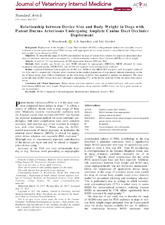| dc.creator | Wesselowski, Sonya | |
| dc.creator | Saunders, Ashley B. | |
| dc.creator | Gordon, Sonya G. | |
| dc.date.accessioned | 2018-08-30T16:00:45Z | |
| dc.date.available | 2018-08-30T16:00:45Z | |
| dc.date.issued | 2017-09 | |
| dc.identifier.citation | Wesselowski, S. , Saunders, A. and Gordon, S. (2017), Relationship between Device Size and Body Weight in Dogs with Patent Ductus Arteriosus Undergoing Amplatz Canine Duct Occluder Deployment. J Vet Intern Med, 31: 1388-1391. doi:10.1111/jvim.14797 | en |
| dc.identifier.uri | https://hdl.handle.net/1969.1/169520 | |
| dc.description.abstract | Background
Deployment of the Amplatz Canine Duct Occluder (ACDO) is the preferred method for minimally invasive occlusion of patent ductus arteriosus (PDA) in dogs, with appropriate device sizing crucial to successful closure. Dogs of any body weight can be affected by PDA.
Objectives
To describe the range of ACDO sizes deployed in dogs of various body weights for improved procedural planning and inventory selection and to investigate for correlation between minimal ductal diameter (MDD) and body weight.
Animals
A total of 152 dogs undergoing ACDO deployment between 2008 and 2016.
Methods
Body weight, age, breed, sex, and MDD obtained by angiography (MDD‐A), MDD obtained by transesophageal echocardiography (MDD‐TEE), and ACDO size deployed were retrospectively evaluated.
Results
Correlation between body weight and ACDO size, MDD‐A and MDD‐TEE was poor, with R‐squared values of 0.4, 0.36, and 0.3, respectively. Femoral artery diameter in the smallest population of dogs placed inherent limitations on the use of larger device sizes, with no limitations on the wide range of device sizes required as patient size increased. The most commonly used ACDO devices were size 3 through 6, representing 57% of the devices deployed within the entire study population.
Conclusions and Clinical Importance
Patent ductus arteriosus anatomy varies on an individual basis, with poor correlation between MDD and body weight. Weight‐based assumptions about expected ACDO device size for a given patient are not recommended. | en |
| dc.language.iso | en_US | |
| dc.publisher | American College of Veterinary Internal Medicine | |
| dc.rights | Attribution-NonCommercial-NoDerivs 3.0 United States | en |
| dc.rights.uri | http://creativecommons.org/licenses/by-nc-nd/3.0/us/ | |
| dc.subject | Veterinary | en |
| dc.subject | Cardiology | en |
| dc.subject | Patent ductus arteriosus | en |
| dc.title | Relationship between Device Size and Body Weight in Dogs with Patent Ductus Arteriosus Undergoing Amplatz Canine Duct Occluder Deployment | en |
| dc.type | Article | en |
| local.department | Other | en |
| dc.identifier.doi | 10.1111/jvim.14797 | |



